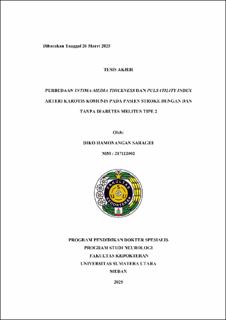Perbedaan Intima-Media Thickness dan Pulsatility Index Arteri Karotis Komunis Pada Pasien Stroke Dengan dan Tanpa Diabetes Melitus Tipe 2
Differences In Intima-Media Thickness and Pulsatility Index of Common Carotid Artery In Stroke Patients With and Without Type 2 Diabetes Mellitus

Date
2025Author
Saragih, Diko Hamonangan
Advisor(s)
Arina, Cut Aria
Batubara, Chairil Amin
Metadata
Show full item recordAbstract
Background:
Stroke is the second leading cause of death worldwide and a major cause of disability. Type 2 diabetes mellitus (T2DM) is an important risk factor that exacerbates atherosclerosis and increases the risk of stroke. Intima-Media Thickness (IMT) and Pulsatility Index (PI) measurements of the common carotid artery are valuable vascular markers to detect atherosclerosis and hemodynamic alterations in stroke patients, especially those with T2DM.
Objective:
To investigate the differences in IMT and PI of the common carotid artery in stroke patients with and without Type 2 Diabetes Mellitus at Haji Adam Malik General Hospital, Medan.
Methods:
This study employed an analytical observational design with a cross-sectional approach. The subjects included ischemic and hemorrhagic stroke patients who met the inclusion and exclusion criteria. The IMT and PI measurements were performed using Doppler ultrasonography. Data were analyzed using comparative statistical tests to assess differences between stroke patients with and without T2DM.
Results:
The IMT of the common carotid artery was significantly higher in stroke patients with T2DM compared to those without T2DM (1.55±0.23 mm vs. 0.88±0.28 mm; p<0.001). The Pulsatility Index (PI) was also significantly higher in stroke patients with T2DM (2.00±0.32 vs. 1.39±0.12; p<0.001), although some variation was observed depending on the type of stroke (ischemic or hemorrhagic). These differences indicate increased arterial stiffness and cerebrovascular resistance in stroke patients with T2DM.
Conclusion:
There are significant differences in IMT and PI of the common carotid artery between stroke patients with and without Type 2 Diabetes Mellitus. The IMT and PI measurements may serve as non-invasive indicators to assess the severity of atherosclerosis and hemodynamic changes in stroke patients, particularly those with comorbid T2DM
Collections
- Master Theses [156]
